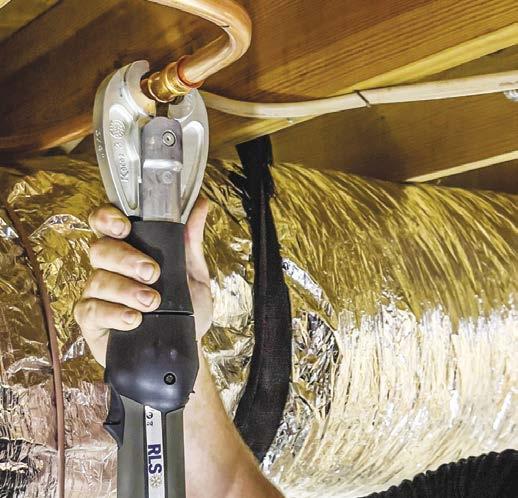
5 minute read
INVISIBLE LINKS
An innovative research project initiated by the City of Melbourne has found a simple way to reduce energy consumption in office buildings while also decreasing the transmission of COVID-19. Louise Belfield reports.
The City of Melbourne is facing a twofold challenge. The first is to achieve zero carbon emissions by 2040. The second is to help save small businesses by attracting up to 40,000 office workers back to the CBD following COVID 19 disruptions. At first glance, one seems incompatible with the other.
Advertisement
Data from the Property Council of Australia shows Melbourne’s CBD occupancy rate dropped from 49 per cent to 38 per cent in July 2022. This was far lower than in all other capital cities, with Perth being the top performer at 71 per cent.
Understandably, retailers in Melbourne’s CBD are desperate for more workers to return to offices to help boost trade. Melbourne Lord Mayor Sally Capp says unless the return to office rate improves, business owners are “running out of choices” with many “on their last legs, trying desperately to stay alive”. But how to convince workers that it’s safe to go back into the water?
A Breath Of Fresh Air
Enter the Building Retrofit for Efficiency, Air Quality, Thermal Comfort and Health (BREATH) project – a research pilot project initiated by the City of Melbourne in collaboration with Cbus Property, the University of Melbourne, A.G. Coombs engineering, SEED engineering, Aurecon, Cundall, and Westaflex Australia. Designed to bring workers back to the city while reducing carbon emissions, the project has been lauded as an outstanding success by all involved.
“BREATH is a world first collaboration between local government, industry and academics, and has given us the knowledge to predict the best type of retrofit to simultaneously reduce carbon footprint and infectious disease transmission,” says Jason Monty, Professor of Fluid Mechanics and Head of Mechanical Engineering at the University of Melbourne.
“Since the majority of city energy cost goes to ventilation of our buildings, the outcomes from BREATH will improve our ability to reach net zero carbon faster.”
That’s good news for Melbourne’s Deputy Lord Mayor Nicholas Reece. “Bringing people back to the [CBD] safely is a key priority for us,” he says.
“This industry leading research has identified simple but effective changes that can be implemented in office buildings to help workers feel safe, comfortable and protected … We encourage building owners, tenants and partners to take [these findings] on board, and to help us create more healthy and sustainable workspaces in the CBD.”
Project Objectives
The primary aim of the BREATH project was to test different air conditioning and ventilation rapid retrofit options that could be used to reduce the risk of aerosolised viral spread, particularly within a post‑COVID return to offices context, while also considering the energy, cost and thermal comfort impacts of the proposed solutions.
“We worked closely with clients, industry and government during the pandemic to highlight the role that ventilation in buildings can play in mitigating the transmission of aerosol borne diseases,” says Andrew Nagarajah, Senior Engineer of Sustainability at building services and HVAC specialists A.G. Coombs.
“Our participation in the BREATH project is a natural extension of that. Post COVID it is essential that building owners, occupiers and HVAC designers and service providers have an enhanced understanding of air distribution in the built environment and how this can be better configured to significantly reduce aerosol spread of disease.”
The project involved a group of industry experts in a community of practice to review and test assumptions and to discuss outcomes. This included sustainable engineering firm Cundall, with its track record of building retrofits and creation of high performance buildings. Amin Azarmi, M.AIRAH, a Cundall associate, says the BREATH project aimed to establish data and evidence on how HVAC solutions could provide a healthier workplace in an energy efficient manner. Studies focused on improving the filtration of the air conditioning system, using installed equipment in an office space donated by Cbus specifically for the project.
“This office space enabled Melbourne University, Melbourne City Council and the HVAC industry experts to come together to develop and test energy efficient solutions and ensure proposed retrofits to effectively reduce the virus transmission,” Azarmi says.
The pilot test evaluated three different ventilation systems on the first floor of the vacant CBD building over three months. These were:
• Displacement ventilation air conditioning
• In ceiling HEPA air filters
• Natural airflow through open windows. A.G. Coombs was responsible for the design, installation and commissioning of the displacement ventilation air conditioning. The other retrofit design, the in ceiling HEPA filtered air conditioning, was by Westaflex.
Key Takeaways
When comparing each of the two retrofit solutions against the base-case scenario of openable windows operating in conjunction with the base-building’s conventional mixed-air overhead air conditioning system, Andrew Nagarajah, Senior Engineer of Sustainability at A.G. Coombs says:
1. In ceiling filtration was essentially the more cost effective, practical retrofit solution. With an installation cost of approximately $28/m2, it had comparable aerosol transmission reduction to the open window scenario (in the order of a 50 per cent reduction in modelled aerosol spread) while using 10–20 per cent less energy than the open window scenario.
2. The column based displacement ventilation solution, at an installation cost of approximately $170/m2, reduced aerosol spread by more than 80 per cent, while using 20–40 per cent less energy than the open‑window scenario. The superior results of this retrofit solution need to be weighed carefully against its higher installation costs, retrofit practicality, and increased engineering design considerations, when compared to the relatively simpler in ceiling filtration solution. ■
“Both retrofit solutions were compared against the baseline scenario of utilising openable windows in conjunction with the base building’s conventional mixed‑air overhead air conditioning system,”
A. G. Coombs’ Nagarajah
explains.
“Here, the openable windows were operated in accordance with ASHRAE recommendations as the ‘conventional’ solution (in the context of the project) to minimising aerosolised viral spread.”
Project Findings
Cundall’s Azarmi says all three options “demonstrated improvements for reducing airborne virus spread compared to business as usual”.
“The key finding was that it is possible to retrofit improvements to ventilation systems that will improve worker safety and indoor air quality while also ensuring energy efficiency,” he says. “The research also showed the assumption that opening windows would be a suitable solution counter intuitively increases energy consumption by between 10 and 20 per cent, as the HVAC system needs to address resulting thermal comfort issues.”
In summary, the project found:
• All three ventilation systems reduced the potential transmission of airborne viruses when compared to standard ceiling based air conditioning, improving safety for office workers
• Displacement ventilation air conditioning – which supplies air from floor level – was the most effective and energy efficient system tested, reducing COVID 19 transmission by 83 per cent, while also reducing energy consumption by 20 per cent
• Displacement ventilation is the most expensive to install, but there are no additional ongoing maintenance costs
• In ceiling air filters reduced virus transmission by 49 per cent but resulted in a minor increase in energy consumption
Opening windows reduced virus transmission by 53 per cent, but increased energy use by up to 20 per cent with seasonal temperature variations
• Opening windows is not available to all office buildings and is not always a viable solution due to Melbourne’s climate.
Nagarajah says the project successfully demonstrated that “rapid retrofit ventilation solutions can create healthier office environments by minimising the recirculation of air and thereby reducing the potential for airborne virus transmission, while simultaneously reducing HVAC energy consumption against conventional increased ventilation strategies”.
A critical part of the project was the peer review carried out by international engineering, management, design, planning, project management, consulting and advisory company Aurecon. Peter Mathieson, F.AIRAH, Aurecon Australasia’s Technical Director of the Built Environment, says that Aurecon gave feedback on the research project assumptions and trial set up including









